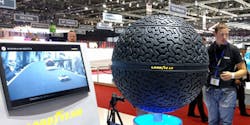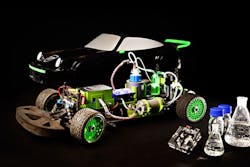The 3D Three: Ultimate Fighting Cat, a Super Tire & Formic Acid Cars
Unleash the Cats of War
For anyone who fears that a declawed cat is left defenseless, we humbly submit to you Cat Armor, created by Thingiverse user J Wall. To create this battle cat, you don’t need the power of Greyskull; a 3D printer will suffice.
Don't try cat "breading" with this orange tabby.
(Photo by Print That Thing)
Lovingly and meticulously designed for his feline friend Bobo, this spiky 3D-printed armor is interconnected plastic plating that covers the cat’s backside and ends in a scorpion-shaped tail.
As you can imagine, J Wall says the modeling phase took “forever.” The end result makes Bobo the most fearsome of man’s best frenemy since the laser cat.
It has a few utilitarian features as well. There’s a spot near the neck for a leash and the skull in the breastplate can hold a pinch of cat nip, because war is hell, after all.
J Wall has challenged the Thingiverse community, and any other 3D-printing/cat lovers, to complete the battle armor drawing a suitable helm and sending the design to any of PrintThatThing’s social media accounts. A drawing will do and The winner gets the armor and the helmet for free.
The Eagle-360 Has Landed (Kind of)
As more car companies are hopping onto the self-driving bandwagon, Goodyear has released a concept tire that takes advantage of having an omniscient robot behind the wheel – by using spheres. The Eagle-360, announced at the 86th Geneva International Motor Show, is a 3D-printed tire that wouldn’t physically be connected to the chassis; magnetic levitation would keep them from bouncing away like a superball. This provides 360 deg movement and allows the car to move any direction with grace and ease, without changing the car's orientation. It’s as much an upgrade as R2-D2 to BB-8.
Goodyear shows off the Eagle-360 tire.
Photo courtesy @Goodyearpress
It would be IoT connected though, employing sensors to gather traffic, road and weather data. The 3D printing allows for an intricate tread pattern inspired by brain coral and sponges that stiffens in dry weather ad resists aquaplaning in wet conditions.
Goodyear wouldn’t give any more details on the amazing innovation just yet, so watching this amazing video, which is 1000 times more interesting than the Speed Racer movie, will have to suffice for now.
Hydrogen Car 2.0?
Creating model cars has always been a great way to teach kids about engineering, or so I’m told. In high school physics I was tasked with building a mousetrap racer, which could only use the stored energy of the spring mechanism as locomotion. My hurried prototype exploded at the start line, though I remember one clever student used a mousetrap and some strings housed within a bike tire to roll more than 60 ft.
Team FAST Prototype System Formauto Jr. formic acid scale model.
(Photo by Ultimaker)
That was a high school kid with some household items. With an Ultimaker 3D printer and a formic acid battery, graduate students in the Netherlands have a working prototype that could one day be the carbon-neutral transport of the future.
Formic acid, or HCO2H, can be broken down into hydrogen carbon dioxide by using a catalyst invented at Eindhoven University of Technology. The school’s 22-member Team FAST (Formic Acid Sustainable Transportation) is leveraging that catalyst in a model car it hopes will provide a sustainable car that would reduce global carbon emissions.
How Team FAST expects formic acid will lead to a carbon-neutral engine.
(Infographic courtesy Team FAST)
It is a fire proof, explosion proof liquid that is double the energy density of the current market’s best batteries. That means the storage and transportation would not lead to a Hindenburg-type event happening on your local interstate.
And unlike with a Tesla electric car, which needs a special charging station, a formic acid car refuel would be “just as easy as putting the fuel hose at your local gas station into your car and waiting until the tank is full.” So the infrastructure is already there.
This all sounds too good to be true and it very well could be. The fuel cell requires platinum, a precious metal which is $974.00/oz. Currently, Gold is $1,257.80/oz. This could make the worldwide use cost prohibitive. Team FAST says the platinum could be recycled from diesel vehicles’ catalytic converters, and that carbon nanotubes may someday serve as a replacement.
Feel free to advocate or poke holes in the team’s idea in the comment section below. I did a lot better in chemistry than I did in physics, but I still have no idea if this idea will go the distance or not get past the start line.
About the Author
John Hitch
Editor, Fleet Maintenance
John Hitch, based out of Cleveland, Ohio, is the editor of Fleet Maintenance, a B2B magazine that addresses the service needs for all commercial vehicle makes and models (Classes 1-8), ranging from shop management strategies to the latest tools to enhance uptime.
He previously wrote about equipment and fleet operations and management for FleetOwner, and prior to that, manufacturing and advanced technology for IndustryWeek and New Equipment Digest. He is an award-winning journalist and former sonar technician aboard a nuclear-powered submarine where he served honorably aboard the fast-attack submarine USS Oklahoma City (SSN-723).





